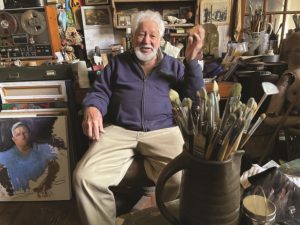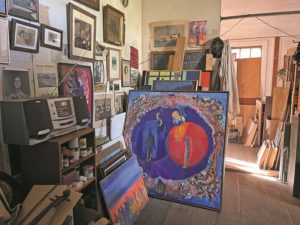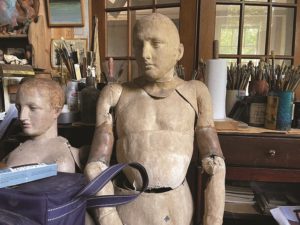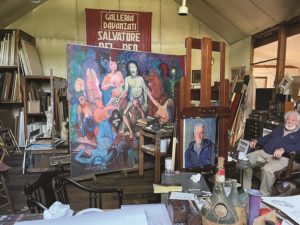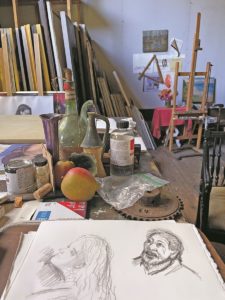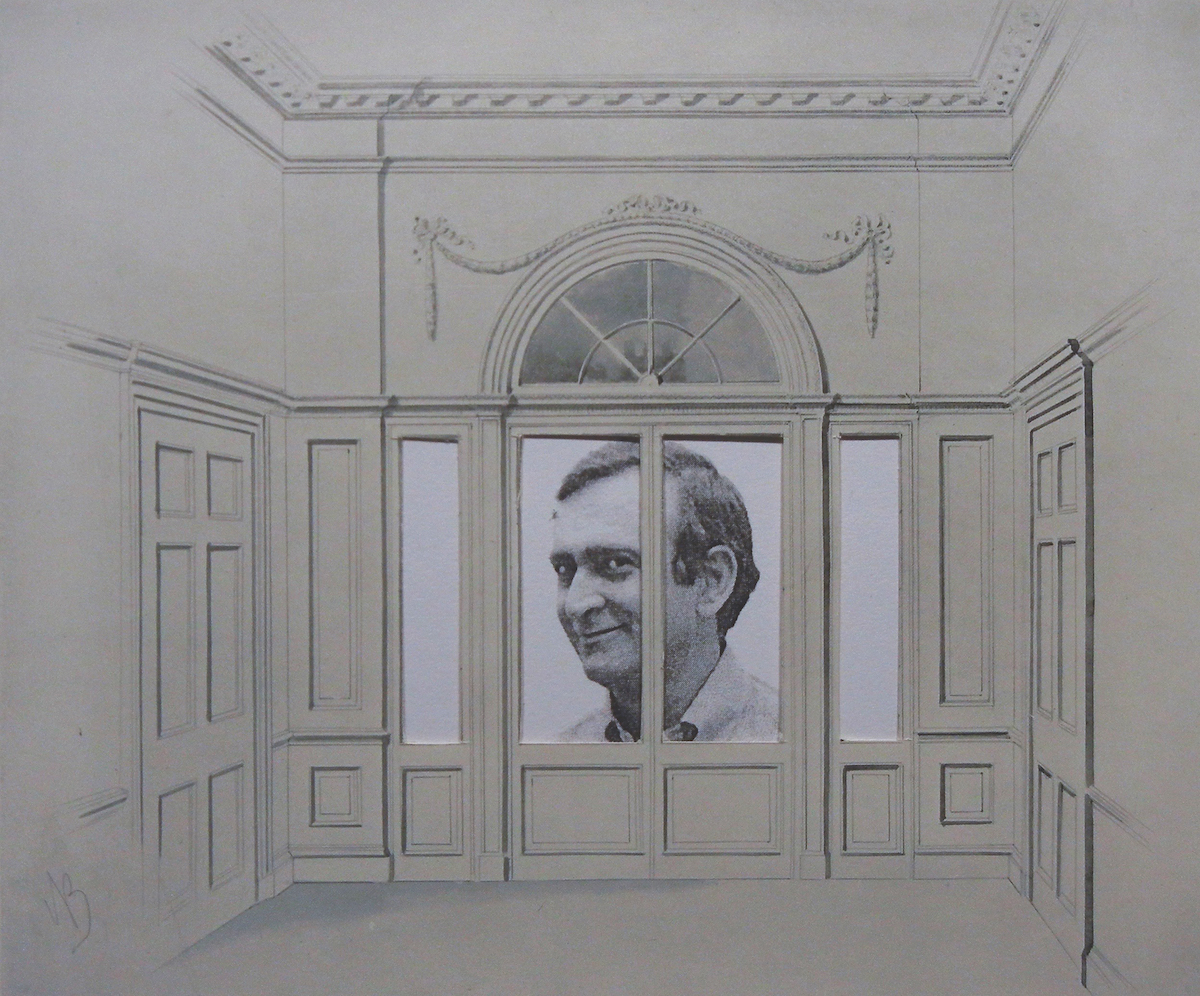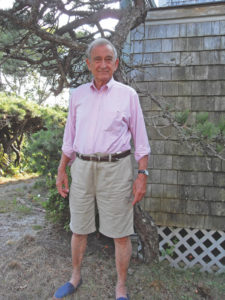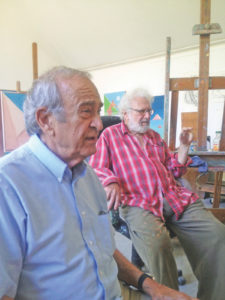In one of Salvatore Del Deo’s paintings now at his solo exhibition at the Provincetown Art Association and Museum, the town is framed through a pair of binoculars — a view one might see from the Pilgrim Monument. The circular shapes converge on a strip of land sandwiched between a purple sky and deep-blue water.
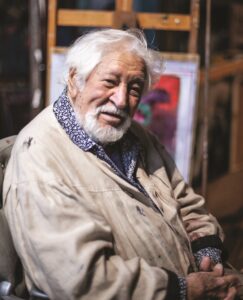
The circularity alludes to Del Deo’s eyes, which, for 75 years, have observed and painted Provincetown’s landscape and community. The show is about Del Deo’s love for this town where, at 95, he continues to build a life as an artist.
Del Deo first heard about Provincetown from his brother Silvestro when he was growing up in an Italian-immigrant family in Providence, R.I. Silvestro, older and already an artist, would tell his brother stories about painters, composers, and poets as they were drifting off to sleep. At 14 or 15, Silvestro visited Provincetown — which he had heard was full of painters, fishermen, and colors. When he returned, he was “beaming with excitement and happiness,” says Del Deo. “ ‘It’s like being in Europe,’ my brother said. ‘You’ve got to go there someday.’ ”
Del Deo made it to Provincetown as an art student when he came to study with Henry Hensche. Silvestro had died of a blood disease at 19. Years later, Del Deo acquired Silvestro’s papers from an older brother. Searching through those documents recently, he discovered a letter in which Silvestro wrote about Provincetown as the place where his brother should be.
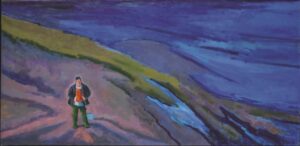
Silvestro was right. From the beginning, Provincetown captured Del Deo’s imagination. “After I got out of the Army,” he says, “I met my wife ,and we decided to stay and make a life here.”
Del Deo is part of a dwindling cohort of artists who studied in Provincetown in the 1940s and ’50s, when the town was still an influential place of learning for young artists, dominated by teachers such as Hensche and Hans Hofmann.
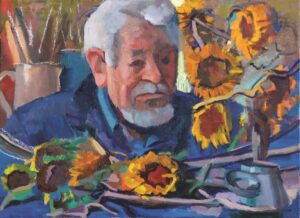
One of the pleasures of the current exhibition, on view through Nov. 26, is that it charts the developments in Del Deo’s adventurous painting career. In a self-portrait with sunflowers from this year, his color is his own: vibrant and chromatic. The dance between the complementary blues and oranges also shows up in a large-scale narrative painting in his studio. Based on Flaubert’s The Temptation of St. Anthony, the painting was started in 1972 and finished just last year after sitting in Del Deo’s studio for decades. “My color is richer,” he says of the painting. “I take a lot more liberties now than I used to.”
In his Provincetown studio, Del Deo says he approaches landscape painting like Cezanne, who was concerned with finding geometric structure in the landscape through an emphasis on horizontal and vertical gestures. In Breakwater, Del Deo establishes horizontal movement through the umber slice of land on the horizon and quick, unfussy brush strokes defining the blue expanses of sky and water. The vertical element is achieved through a triangle of rocks leading into the water. A few light shapes of color among the dark rocks economically convey the specific quality of magic-hour light on the Outer Cape.
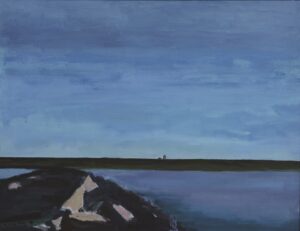
The simplicity of this painting echoes through the exhibition, particularly in Pilgrim Lake #2, a serene, horizontal composition of a dune and its reflection, and Shoreline Community, a composition dominated in the center by an empty expanse of illuminated sand and punctuated in the distance by seagulls, rendered in flicks of paint, pecking at urchins and clams. His portraits, a territory where Del Deo seems most at ease, convey a similar warm austerity in their lack of finish and emphasis on the geometric structure of the faces.
Del Deo draws parallels between his distilled approach to painting and that of Corot, another Old Master, whom Del Deo quotes: “When you paint, leave as much as you can of the reality in front of you out of the picture. Include just enough to cling to an idea but not a reproduction of what’s in front of you.” It’s advice he continues to live by. “I think I’m just beginning to be a painter,” he says.
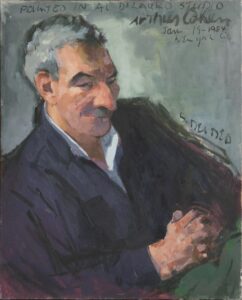
In his studio, Del Deo appears like an Old Master himself, with his tousled white hair, sitting in a paint-covered smock among easels with works in process, stacks of paintings, still-life set-ups, and antique mannequins. The studio, in a hollow at the end of a woodsy dirt road, recalls an older Provincetown, something less manicured and more rural.
On his desk, he has a pastel drawing of his late wife, Josephine, at Frenchie’s dune shack. Josephine, who was a poet, writer, and devotee of Provincetown’s art community, is often on Sal’s mind.
“My wife was so supportive,” he says. “I suffered from self-doubt, and she was there all the time encouraging me to keep painting. I did the same with her and her poetry.”
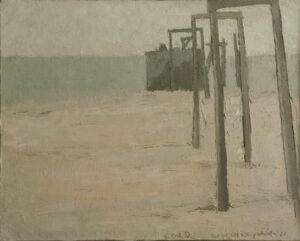
In a recent lecture at PAAM, Del Deo told stories about the artists he painted and characters associated with his other paintings. A picture of the dune shack introduced a story about its former owner, Jeanne “Frenchie” Chanel, a dancer and singer who lived in Paris before visiting Provincetown with her friend Bette Davis. Davis left, but Frenchie remained, where she developed a passion for nursing wounded birds back to health.
When he introduced one of his most recent paintings, Ghost Wharf, his tone became more elegiac. “I did this a few months ago from memory,” he said. “It epitomizes what was out there once. This was a real working town. Now, unfortunately, it’s not.”
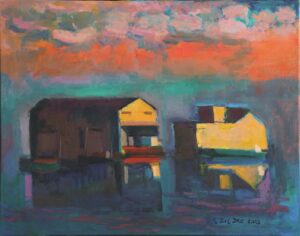
The town’s fishing industry initially attracted Del Deo to Provincetown. In Ghost Wharf, the sunset colors speak of its waning presence. The wharfs sit surrounded by water, vulnerable and untethered to land, but Del Deo captures a fleeting moment of yellow light before the sun goes down — an ephemeral but very real, very beautiful presence.
Del Deo, in the sunset of his own life, remains vital, full of curiosity, and continually engaged with the world around him. In his studio, he tells another story about an artist who gave him a book before he died at 46.
“He wrote an inscription in the cover: ‘Dear Sal, Carry on,’ and then signed his name,” says Del Deo. “I said, ‘Jesus, I have to carry on for all my dear friends who were painters and never lived as long as I have. I have to continue until I can’t paint anymore.’ ”
Taking Liberties
The event: Sal Del Deo, 75 years of painting in Provincetown
The time: Through Nov. 26
The place: Provincetown Art Association and Museum, 460 Commercial St.
The cost: General admission: $15
